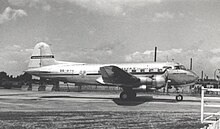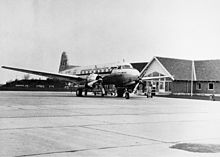Saab 90 (airplane)
| Saab 90 Scandia | |
|---|---|
 Saab 90 "Scandia" (model) |
|
| Type: | Twin-engine airliner |
| Design country: | |
| Manufacturer: | |
| First flight: |
November 16, 1946 |
| Commissioning: |
October 1950 |
| Number of pieces: |
19th |
The Saab 90 Scandia is a twin-engine airliner produced by the Swedish manufacturer Saab . It is a low-wing aircraft with a retractable nose wheel landing gear that was powered by two piston motors.
development
When the end of the Second World War was in sight, Saab made analyzes of the sales opportunities after the end of the fighting. It was decided to start two civil aircraft projects, on the one hand the Saab 91 as a touring aircraft and the Saab 90 as a commercial aircraft. The need was clarified with the Swedish Air Force , which was looking for a successor to the Junkers Ju 86 , i.e. a combined bomb and airliner, and the airline AB Aerotransport , which wanted to procure a pure airliner. As a compromise, they agreed to develop a commercial aircraft that could also be used as a military transporter. On February 28, 1944, the Saab Supervisory Board then decided to develop the Saab 90.
The project manager for this development was Tord Lidmalm . The first development goal was a short-haul aircraft with a range of 1000 km and space for 25 to 30 passengers. Great emphasis was also placed on good slow flight characteristics and short take-off and landing distances. A pressurized cabin was not provided. The prototype made its maiden flight on November 16, 1946 and performed well. The AB Aerotransport then ordered 10 machines for a purchase price of 15 million crowns .
production
Due to the political developments of the Cold War , the Swedish government gave priority to the production of the Saab 29 Tunnan fighter jet . The production of the Saab 90 was then relocated to Fokker . For the lost profit Saab was paid compensation by the Swedish Air Force .
After the integration of AB Aerotransport into SAS (Scandinavian Airlines System) in June 1948, a total of 8 Saab 90s were delivered to the latter from October 1950. Another 10 were exported to Brazil, where they were used by the VASP (Viação Aérea São Paulo) . The 8 Swedish machines were also sold to Brazil in 1957/58 and remained in use until 1969.
Incidents
There were 5 total losses during the operation of Scandia , all of them at VASP; in 3 of them a total of 64 people were killed. Full list:
- On December 30, 1958, a Saab Scandia of VASP (Viação Aérea São Paulo) ( aircraft registration PP-SQE) took off from Rio de Janeiro-Santos Dumont Airport for a flight to São Paulo-Congonhas Airport . During take-off, engine no. 1 (left) failed at a height of 50 meters. While attempting to return, it stalled and the plane crashed in Guanabara Bay . 21 of the 37 inmates were killed.
- On September 23, 1959, a Saab Scandia operated by VASP (PP-SQV) did not gain sufficient height when taking off from São Paulo-Congonhas Airport and crashed almost 5 kilometers south of the airport into a residential area. The plane was on its way to Rio de Janeiro-Santos Dumont Airport. All 20 inmates died.
- On August 15, 1960, a fire broke out in the front luggage compartment of a Saab Scandia operated by VASP (PP-SQS) on the flight from São Paulo-Viracopos Airport to Uberlandia . The master did not operate the fire extinguishing system because he believed that this would further impair the already poor visibility in the cockpit. During the emergency landing on the return to Viracopos, the machine rolled over the end of the runway and got into an area where construction work was being carried out. All occupants survived, but the aircraft was destroyed.
- On November 26, 1962, a Saab Scandia of the VASP (PP-SRA) collided head-on with a Cessna 310 (PT-BRQ) on the flight from São Paulo-Congonhas Airport to Rio de Janeiro-Santos Dumont Airport near Paraibuna at an altitude of 2,400 m . The weather conditions were described as "excellent" in the investigation report. All 23 occupants as well as the four of the Cessna were killed.
- On March 8, 1964, a VASP (PP-SQY) Saab Scandia landed very hard on a training flight at Londrina Airport . The aircraft was damaged beyond repair, but all four crew members survived.
Technical data Saab 90 A-2
- Wing aspect ratio: 9.15
- Wing area: 85.7 m²
- Track width: 6.96 m
- Wheelbase: 5.93 m
- Engine: 2 × Pratt & Whitney R-2180 with 1400 HP each. With water injection 1800 HP.
- Passengers: 24 or 32
- Crew: 4
- Span: 28.0 m
- Length: 21.3 m
- Height: 7.08 m
- Empty weight: 9960 kg
- Max. Takeoff weight: 16000 kg
- Top speed: 450 km / h
- Cruising speed: 391 km / h
- Stall speed: 130 km / h
- Climbing speed: 410 m / min
- Service ceiling: 7500 m
- Range: 2510 km
See also
Web links
literature
- “Jane's all the World's aircraft” 1956/57
- “The Saab-Scania Story”, 1987, Stockholm, ISBN 91-7886-027-X
- John Stroud: European Transport Aircraft since 1910. Putnam & Company, London 1966, pp. 511-513.
Individual evidence
- ↑ Accident statistics SAAB Scandia, Aviation Safety Network (English) , accessed on January 23, 2016.
- ↑ Accident report SAAB Scandia PP-SQE , Aviation Safety Network (English), accessed on August 3, 2019.
- ↑ ICAO Aircraft Accident Digest No. 10 Volume II, Circular 59-AN / 54 (English), p. 246.
- ↑ Accident report SAAB Scandia PP-SQV , Aviation Safety Network (English), accessed on August 3, 2019.
- ↑ Accident report SAAB Scandia PP-SQS , Aviation Safety Network (English), accessed on August 3, 2019.
- ↑ ICAO Aircraft Accident Digest No. 17 Volume II, Circular 71-AN / 63 (English), pp. 137-139.
- ↑ Accident report SAAB Scandia PP-SRA , Aviation Safety Network (English), accessed on August 3, 2019.
- ↑ Accident report SAAB Scandia PP-SQY , Aviation Safety Network (English), accessed on August 3, 2019.



